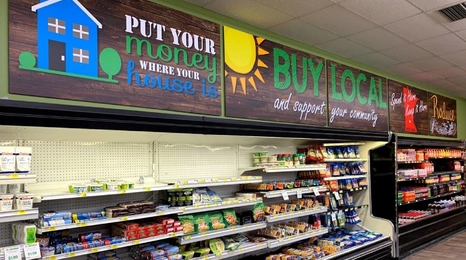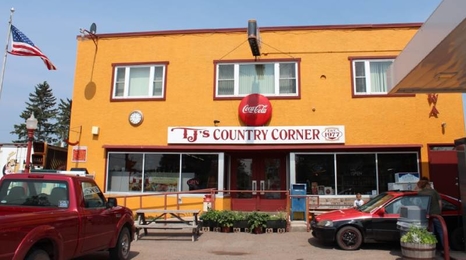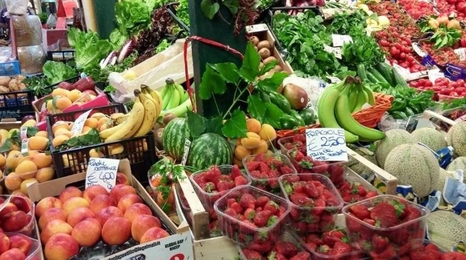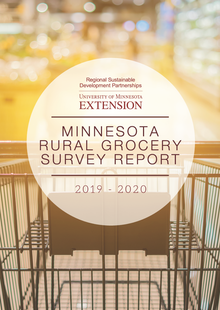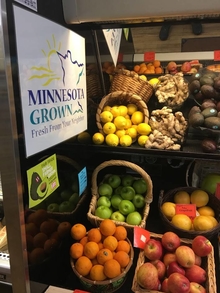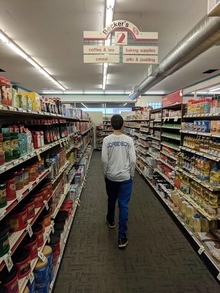Explore more projects and resources related to rural grocery stores from the University of Minnesota Extension.
Rural grocery stores are Main Street anchors in more than 200 towns across Greater Minnesota.
Most are small, independent businesses with owners who live in the same community as their store and who take great pride in their work. Many face significant challenges such as growing competition from dollar stores but are still finding ways to adapt, including by strengthening connections to the local food system.
These are a few key findings from a new survey of rural grocers in Minnesota, which explores the unique opportunities, needs and challenges facing these essential businesses.
Published in November 2020, the Minnesota Rural Grocery Survey Report shares results from a recent statewide survey of rural grocery stores conducted by the University of Minnesota Extension Regional Sustainable Development Partnerships (RSDP).
“We are excited about these new findings,” said Kathy Draeger, RSDP statewide director and principal investigator of the survey. “The Regional Partnerships and Extension have covered and plugged into this topic locally, regionally and nationally, for over a decade. We’ve now honed back in to understand what has changed for grocers and what they need from their University of Minnesota.”
Grocery stores in communities with 2,500 or fewer residents were eligible to participate in the survey. Of the 235 identified and eligible stores in Minnesota, 129 responded to the statewide survey (55% response rate).
Competition from dollar stores
While most rural grocers in Minnesota expressed feeling positive about the state of their business, the survey found that 88 percent of respondents are concerned about their store’s longer-term economic sustainability and 49 percent are concerned that their store will go out of business in the next five years.
Unpacking these concerns, surveyed grocers most frequently reported major challenges in the form of high operating costs and competition with dollar stores, an issue which has emerged over the past five years.
“We found most rural grocery stores have profit margins of just over one percent, which is slightly less than industry average. It’s clear rural grocers are not running their business for solely monetary reasons. To better serve their communities, grocers reported that they often prioritize their business over their personal needs,” explained Dr. Hye-Young Kim, report co-author and interim department head in the College of Design.
“They value the responsibility they have to their community, but these businesses still face considerable stress, especially in terms of competition from dollar stores,” said Ren Olive, report co-author and RSDP program associate, who helped lead the survey.
The research team found that a majority of rural grocery stores in Greater Minnesota have at least one dollar store within a 15-mile radius. Drawing on national studies that have tracked the growth of dollar stores and their potential to disrupt local economies, the survey explored how rural grocers in Greater Minnesota have perceived a proliferation of dollar stores and how their sales have been impacted.
One survey respondent described a significant and noticeable impact on their business when a dollar store opened in their community.
“I lost over 30 percent the day [the dollar store] opened and it has continued to take more and more business,” the store owner said.
Many other responses described similar challenges, losses in profits and frustration. Store owners in communities where a dollar store had recently moved to town were more likely to express concerns about their store going out of business.
In addition to the challenges they face from dollar stores, two-thirds of the respondents reported intending to own their store for 10 more years or less. Most grocers surveyed (80%) did not have transition plans for the future ownership of their store. Without clear paths forward in terms of succession planning as grocers retire, rural grocery stores and their communities may be at risk.
Draeger and Olive noted that threats to rural grocery stores and store closures can cause larger ripple effects in the surrounding community.
The survey found that rural grocery stores serve not just individual residents and families, but also nursing homes, hospitals, schools, food shelves, restaurants and other local businesses. They also attract activity in town that helps the local economy.
“If you lose a grocery store in town, people are no longer going there to get their groceries, buy gas, go out to eat at the restaurant or do other business while they are there. Without a grocery store, there is a gap, not just in terms of food access, which is incredibly important, but also this core business that helps maintain the community’s vitality,” Draeger said.
Opportunities for local and fresh food
Despite the challenges facing rural grocery stores in Minnesota, survey results reveal an appetite among rural grocers to find a path forward and continue innovating with investments in the local food system.
The survey found 49 percent of rural grocers purchase local food directly from farmers and from wholesalers, and 41 percent of rural grocers would like more access to local foods. A majority of respondents expressed feeling optimistic about purchasing locally sourced honey, vegetables, syrups, fruits and eggs for their stores. Grocers generally felt less confident purchasing other kinds of products, including locally processed goods, grains, meat or nuts.
“We now have more data about how rural grocers are approaching other emerging topics and opportunities in the sector, including sourcing food locally, selling fresh produce and creatively partnering to help connect local farmers to wholesale markets,” Olive said.
While 97 percent of respondents reported selling fresh produce in their stores, they expressed major barriers to doing so, including finding a sufficient supply of local produce to sell in store (28% of respondents); maintaining the shelf life of local produce (23%); and understanding the rules and regulations for selling local produce (22%).
A Farm to Grocery Toolkit released by RSDP seeks to address some of these barriers by helping store owners navigate the legal and regulatory landscape and methods for purchasing and selling local foods.
Supporting the resilience of rural grocery stores
In addition to notable findings related to competition and local food, the Minnesota Rural Grocery Survey Report contains a wealth of information on other topics that are useful to understanding the needs of rural grocers across Minnesota. These topics include: store characteristics; infrastructure and workforce; business motivations, attitudes and relationships to the community; and product selection and supply chain opportunities for rural grocery stores.
The recent study builds on a larger body of University of Minnesota Extension research on rural grocery stores in the state, including an earlier survey completed in 2015. Compared to the previous survey, the latest study expanded its scope by investigating the impact of dollar stores on rural grocery stores and asking questions about owner perceptions of their business.
Through efforts like these surveys, the University of Minnesota team has created opportunities to connect more deeply with rural grocers throughout the state.
“To get to this deeper understanding of rural grocery stores, it’s been important to learn about who these grocers are as people, what they need and how they are feeling about their businesses,” Olive said.
Drawing on their latest findings, Draeger, Olive and their team will continue to support the resilience of rural grocers across the state. As stores find new ways to operate and innovate in these uncertain times, RSDP has research and resources — including its Support Our Stores technical assistance program, with support from the Minnesota Department of Agriculture’s Good Food Access Program — to ensure Minnesota’s rural grocers and their communities stay viable and sustainable.
“With the diversity of rural grocery stores across the state and the ways they are able to creatively partner and develop different relationships with different sources of food and products — that’s where we see resilience,” Draeger said.
An interdisciplinary team of researchers from the University of Minnesota led by Dr. Kathy Draeger and Ren Olive developed the Minnesota Rural Grocery Survey Report. The team partnered with the Minnesota Center for Survey Research to design and administer the survey by mail from May to October 2019. Other partners, including those from RSDP, Extension and the Minnesota Grocers Association, reviewed the survey findings and final report.


